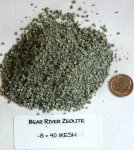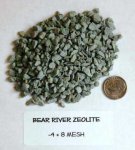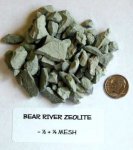Hi everyone,
I have a question for my filter construction. I am setting up a rather different system than an ordinary pond, but the concepts ought to be the same or highly similar.
I have described my filter design in the "INTRODUCTIONS" forum and posted pix in the "PHOTO" section, but if you haven't found them there, I will just make a brief summary here of my personaly filter design.
The drain line from my above ground tank (1,000 gallons) gravity feeds into the bottom of a 55 gallon sediment trap filter.
The water swirls around in the bottom 5-6 inches space of the sediment filter and hopefully drops the heavy and larger loads near the cleanout drain (to be expelled when needed through the flush valve). The water percolates upwards through a homemade, round, plastic disc with holes drilled in it. Just atop this is an aerator device made from 1/2 PVC tubing that I can use to "purge" the filter media above it if it gets too dirty and starts to clog.
The filter media in this sediment filter barrel will be layered rock and gravel and very course sand. Progressively finer as the water rise upwards. The outflow of this 55 gallon tank will feed into the bottom of the 55 gallon bio-converter tank.
The bio-converter tank has a soaker hose aerator that circulates about 2 cubic feet of Kaldnes K3 bio-media aggressively. The outlfow of this 55 gallon bio-converter tank drops down from the top to the bottom of the last tank, which is nothing more than a fine aerator and pump tank to return the water back to the pond.
On the trip back to the pond, there is one final filter device. It is a 4 foot long x 6" diameter, vertical PVC pipe or column. In this column, I was planning on using activated carbon media to clarify the water. However, I am now having second thoughts.
First of all, I just read a post regarding the use of Zeolite. I had planned to use this instead of the coarse sand in my sediment tank. However, the post by Koifishguy recommended that the zeolite NOT be placed upstream from the bio-converter as it would remove the ammonia and deprive the Nitrosomonas bacteria of their food source.
Therefore, rather than placing it there, I was wondering if I should place it in the final filter stage (the 6" column) and use the zeolite exclusively and drop the activated charcoal or carbon out of the picture.
I can get the activated carbon (granulated) from work for free, so that is why I desired this last filter stage design. However, the zeolite can be recycled easily with backflushing and the carbon is just a consumable (disposable) media.
I don't want to mix these two in the same tank or filter mechanism, because then I would have to separate them to save the zeolite and dispose of the carbon or toss them both out when the carbon's life has been exhausted.
I can redesign the last 55 gallon filter barrel in order to place the zeolite in there and still retain the carbon in the PVC column or I can eliminate the carbon entirely and use the zeolite in the PVC column alone. Then, I can merely backflush the zeolite or expel it from the tube and wash it with fresh water to rejuvenate it.
Currently, my design is set up to just disconnect the carbon filter PVC column, dump the carbon out in the garden area or wherever, and refill it with new carbon.
Keep in mind that I am doing something quite different than setting up just a standard "fish pond". I am raising bait fish and there are some unique parameters that I want to follow here to keep the bait tank clean and clear. The fish that I will be raising in this pnnd are definitely not as sensitive as Koi. My fish could live in just about any environment. so I am not too concerned about that. However, I am going to have a LOT of fish in this 1,000 gallon pond/tank, and I want to be able to see them to net them when needed. So, I desire 0 ammonia and nitrite levels and really high water clarity.
When I read the post from KoiGuy, I realized that there was an error in my thinking, because I was pondering placing the Zeolite in the sediment tank in place of the coarse sand. That would have been convenient for me, but then the bacteria in the bio-converter would be deprived of supper!
With what I have designed and constructed so far (refer to what I state above), what is everyone's reccommendations for this situation?
Keep in mind that I do not want to redesign the mechanical parts of this filter later, so I really want it to be good right off the bat. I can make changes now, easily. But, once done, its done. So, I need it to be as correct as possible now.
I may not even need the zeolite, I just thought it was a good option, maybe it is unnecessary? Take a look at my photos (Uncle Gordy's bait tank) and ponder it. Throw any advice my way that you can, I am open to all suggestions, ideas and theories! I think that I have a great design, but I may have to rethink a few of the details before I deem it a finished product. I definitely know that I better not place the Zeolite (if I use it at all) upstream from the bio-converter. I would be defeating the operation of the bacteria if I did. I shoud have had that thought in the back of my mind already, but I was gettin kinda gung-ho and impatient to finish the project.
I want to thank everyone who does reply here, even to those of you who just scratch your head and ponder the idea, I thank you, too!
Gordy
I have a question for my filter construction. I am setting up a rather different system than an ordinary pond, but the concepts ought to be the same or highly similar.
I have described my filter design in the "INTRODUCTIONS" forum and posted pix in the "PHOTO" section, but if you haven't found them there, I will just make a brief summary here of my personaly filter design.
The drain line from my above ground tank (1,000 gallons) gravity feeds into the bottom of a 55 gallon sediment trap filter.
The water swirls around in the bottom 5-6 inches space of the sediment filter and hopefully drops the heavy and larger loads near the cleanout drain (to be expelled when needed through the flush valve). The water percolates upwards through a homemade, round, plastic disc with holes drilled in it. Just atop this is an aerator device made from 1/2 PVC tubing that I can use to "purge" the filter media above it if it gets too dirty and starts to clog.
The filter media in this sediment filter barrel will be layered rock and gravel and very course sand. Progressively finer as the water rise upwards. The outflow of this 55 gallon tank will feed into the bottom of the 55 gallon bio-converter tank.
The bio-converter tank has a soaker hose aerator that circulates about 2 cubic feet of Kaldnes K3 bio-media aggressively. The outlfow of this 55 gallon bio-converter tank drops down from the top to the bottom of the last tank, which is nothing more than a fine aerator and pump tank to return the water back to the pond.
On the trip back to the pond, there is one final filter device. It is a 4 foot long x 6" diameter, vertical PVC pipe or column. In this column, I was planning on using activated carbon media to clarify the water. However, I am now having second thoughts.
First of all, I just read a post regarding the use of Zeolite. I had planned to use this instead of the coarse sand in my sediment tank. However, the post by Koifishguy recommended that the zeolite NOT be placed upstream from the bio-converter as it would remove the ammonia and deprive the Nitrosomonas bacteria of their food source.
Therefore, rather than placing it there, I was wondering if I should place it in the final filter stage (the 6" column) and use the zeolite exclusively and drop the activated charcoal or carbon out of the picture.
I can get the activated carbon (granulated) from work for free, so that is why I desired this last filter stage design. However, the zeolite can be recycled easily with backflushing and the carbon is just a consumable (disposable) media.
I don't want to mix these two in the same tank or filter mechanism, because then I would have to separate them to save the zeolite and dispose of the carbon or toss them both out when the carbon's life has been exhausted.
I can redesign the last 55 gallon filter barrel in order to place the zeolite in there and still retain the carbon in the PVC column or I can eliminate the carbon entirely and use the zeolite in the PVC column alone. Then, I can merely backflush the zeolite or expel it from the tube and wash it with fresh water to rejuvenate it.
Currently, my design is set up to just disconnect the carbon filter PVC column, dump the carbon out in the garden area or wherever, and refill it with new carbon.
Keep in mind that I am doing something quite different than setting up just a standard "fish pond". I am raising bait fish and there are some unique parameters that I want to follow here to keep the bait tank clean and clear. The fish that I will be raising in this pnnd are definitely not as sensitive as Koi. My fish could live in just about any environment. so I am not too concerned about that. However, I am going to have a LOT of fish in this 1,000 gallon pond/tank, and I want to be able to see them to net them when needed. So, I desire 0 ammonia and nitrite levels and really high water clarity.
When I read the post from KoiGuy, I realized that there was an error in my thinking, because I was pondering placing the Zeolite in the sediment tank in place of the coarse sand. That would have been convenient for me, but then the bacteria in the bio-converter would be deprived of supper!
With what I have designed and constructed so far (refer to what I state above), what is everyone's reccommendations for this situation?
Keep in mind that I do not want to redesign the mechanical parts of this filter later, so I really want it to be good right off the bat. I can make changes now, easily. But, once done, its done. So, I need it to be as correct as possible now.
I may not even need the zeolite, I just thought it was a good option, maybe it is unnecessary? Take a look at my photos (Uncle Gordy's bait tank) and ponder it. Throw any advice my way that you can, I am open to all suggestions, ideas and theories! I think that I have a great design, but I may have to rethink a few of the details before I deem it a finished product. I definitely know that I better not place the Zeolite (if I use it at all) upstream from the bio-converter. I would be defeating the operation of the bacteria if I did. I shoud have had that thought in the back of my mind already, but I was gettin kinda gung-ho and impatient to finish the project.
I want to thank everyone who does reply here, even to those of you who just scratch your head and ponder the idea, I thank you, too!
Gordy





